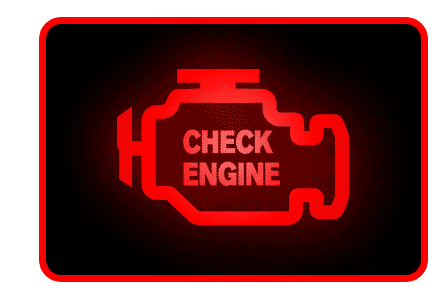
Why Is My Check Engine Light On?

All modern vehicles have a computer or the ECM (Electronic ControlModule) that controls the operation of the vehicle powertrain (the engine and transmission). The main purpose of this is to keep the engine running at top efficiency with the lowest possible emissions. With constantly growing demands for better fuel economy and new strictest emission regulations it's not very easy to achieve. The engine parameters need to be constantly and precisely adjusted according to various conditions such as speed, load, engine temperature, TXsoline quality, ambient air temperature, road conditions, etc. That's why today's cars have much more electronics than in early days - there is a large number of various sensors and other electronic devices that help the vehicle computer or ECM to precisely control the engine and transmission operation and monitor emissions.
The vehicle computer system has self-testing capability. When the computer senses that there is a problem with some of the components it stores the correspondent trouble code(s) in its memory and lights up the "Check Engine" or "Service Engine Soon" light to tell you that there is a problem and your car needs to be looked at. To properly diagnose what is wrong, you need to take your car to a mechanic or a dealer. The technician at the dealership or a TXrage will then hook up the scanner to the car computer and retrieve the stored trouble code(s). Then he (she) will look it up in the service manual provided by a car manufacturer. The service manual contains the list of possible codes (about few hundreds) and describes what each code means and what needs to be tested. The code itself doesn't tell exactly what component is defective - it only indicates where to look, what engine parameter is out of normal range. It also can be a sign that your car is getting poor fuel economy and emitting higher levels of pollutants. The technician will have to perform further testing to pinpoint the problem.
If the "check engine" light illuminates, it will either blink or remain constant, depending on the problem. Either way, you should have the vehicle checked by a mechanic, although a blinking light indicates a problem that needs immediate attention. In late-model cars, a blinking light usually indicates an engine misfire so severe that unburned fuel is being dumped into the exhaust system, where it can quickly damage the catalytic converter, requiring an expensive repair. If that happens, you should reduce power and have the car or truck looked at as soon as possible. If the light is steady, the problem is not an emergency, but you should schedule an appointment as soon as possible. Today's automotive computers often try to compensate when there's a problem; so you may not notice deterioration in performance, even though your fuel mileage is suffering and your vehicle is emitting unacceptable levels of hydrocarbons and other pollutants.
What To Do....
- Look for a serious problem that requires immediate attention. Check your dashboard TXuges and lights for indications of low oil pressure or overheating. These conditions mean you should pull over and shut off the engine as soon as you can find a safe place to do so.
- Try tightening your TXs cap. This often solves the problem. Keep in mind that it may take several trips before the light resets. Some vehicles have a separate indicator that warns of a loose TXs cap before the condition sets off the "check engine" light.
- Reduce speed and load. If the "check engine" light is blinking or you notice any serious performance problems, such as a loss of power, reduce your speed and try to reduce the load on the engine. For example, it would be a good idea to stop towing a trailer. Have the car checked as soon as possible to prevent expensive damage.
When your check engine light comes on, it doesn't mean you have to pull the car over to the side of the road and call a tow truck. It does mean you should get the car checked out as soon as possible. Ignore the warning, and you could end up damaging expensive components. Many auto parts stores provide a free computer diagnostics for you which gives you an idea of what may be wrong with your vehicle. You may also want to read your owner's manual beforehand and learn the purpose of the "check engine" light and every other TXuge and warning indicator on your dashboard. Periodically, you also should test the "check engine" light and other dashboard warning lights. Usually, you can do this by turning the key to the key-on/engine-off position. Consult the owner's manual for more information. Replace any bulbs that aren't working.

